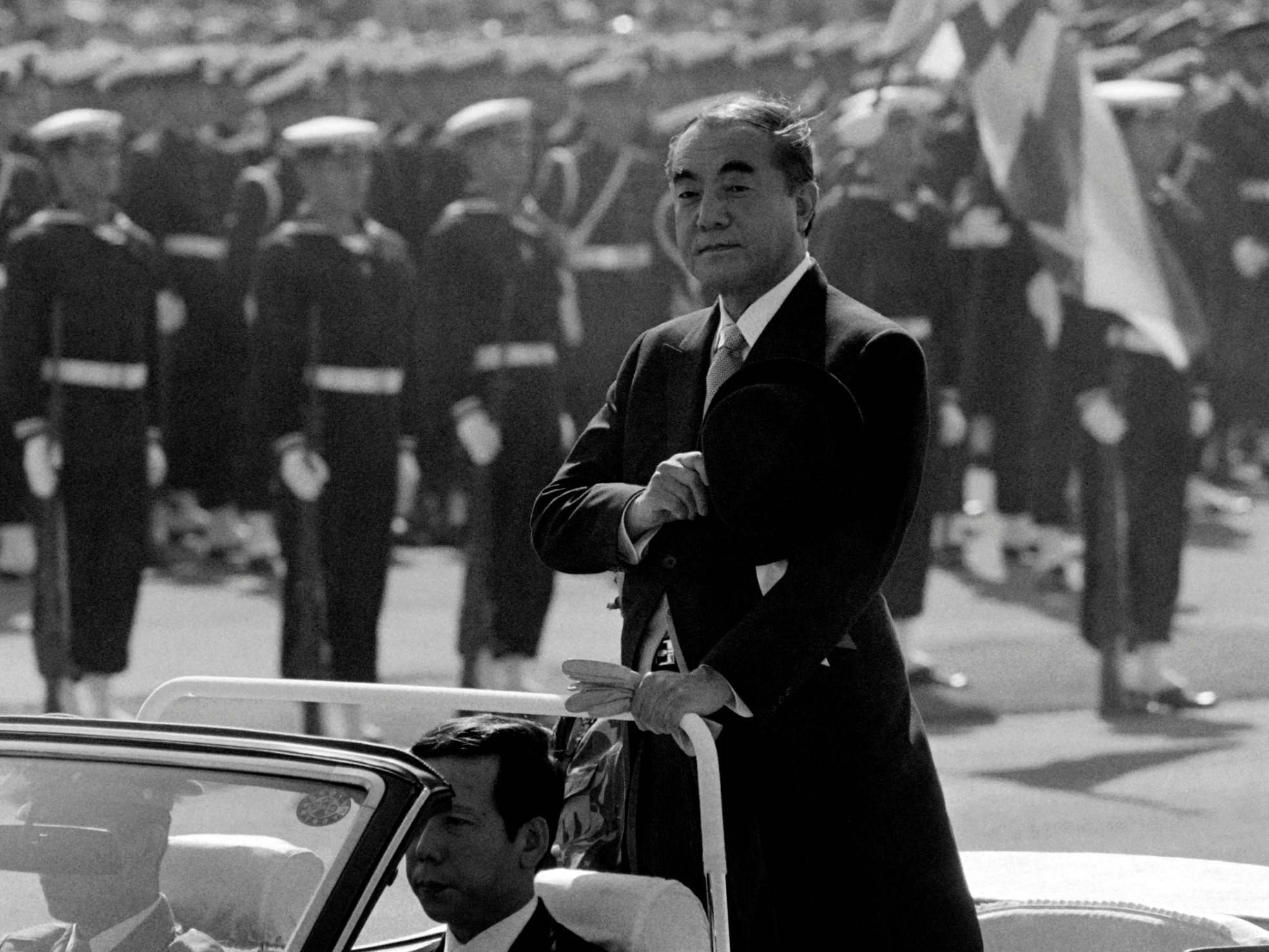Yasuhiro Nakasone: Japanese prime minister at height of country’s economic growth
He was an ally of Ronald Reagan and an advocate of increased military spending and nuclear power

Former Japanese prime minister Yasuhiro Nakasone was a giant of his country’s post-Second World War politics who pushed for a more assertive Japan while strengthening military ties with the United States. As a naval officer in the war, Nakasone witnessed the depths of his country’s utter defeat and devastation. Four decades later, he presided over Japan at the pinnacle of its economic success.
Nakasone, who has died aged 101, began his political career as a fiery nationalist denouncing the US occupation that lasted from 1945 to 1952, but by the 1980s he was a stalwart ally of the United States known for his warm relations with President Ronald Reagan. He boosted defence spending, tried to revise Japan’s US-drafted pacifist constitution and drew criticism for his unabashed appeals to patriotism.
In the 1950s, he was a driving force behind building nuclear reactors in resource-poor Japan, a move that helped to propel the country’s strong economic growth after the Second World War but drew renewed scrutiny in the aftermath of the meltdowns at a nuclear plant in Fukushima swamped by a tsunami in 2011.
Nakasone was born in 1918. His father was a lumber merchant. After attending Tokyo Imperial University, Nakasone worked for the Japanese Interior Ministry and then entered the navy, where he rose to the rank of lieutenant commander during the war. In his last news conference as prime minister, he said his political ambitions were sparked after the war by “the conviction I felt as I gazed bewildered at the burned ruins of Tokyo – how can this country be revived into a happy and flourishing state?”
He established his nationalist credentials by campaigning for parliament while riding a white bicycle bearing the rising sun of the Japanese national flag, which the country’s wartime military had used. He won a seat in 1947, becoming the youngest member of parliament at 28.
Nakasone became a leading figure in the Liberal Democratic Party, which has dominated Japan’s postwar politics. During more than half a century in parliament, he served as defence chief and headed the powerful Ministry of International Trade and Industry before becoming prime minister.
Nakasone assailed the US-drafted postwar constitution, demanding revision of the document’s war-renouncing Article 9 and urging a military build-up. He was a key figure behind providing government funding for nuclear research in 1954, less than a decade after the United States dropped atomic bombs on Hiroshima and Nagasaki, killing as many as 200,000 people in the last days of the war. In 1955, he helped to pass legislation designed to promote nuclear power.
In a 2006 speech marking the 50th anniversary of Japan’s first nuclear institute, Nakasone said he was intrigued by nuclear power as he tried to figure out why Japan lost the war. “My conclusion was that one of the biggest reasons was [the lack of] science and technology,” he said. “I felt strongly that Japan would end up being a lowly farming nation forever unless we take a bold step to develop science and technology.”
After the Fukushima disaster in 2011, there was a public backlash against nuclear energy, but Nakasone said it remained indispensable to maintain Japan’s industrial growth.
As prime minister from 1982 to 1987, Nakasone broke the mould of the Japanese politician with an outspokenness that appealed to voters. His tongue sometimes got him in trouble, and he sparked outrage in 1986 by suggesting Japan was an economic success because it did not have minorities with lower intellectual levels.
Nakasone was staunchly committed to Japan’s alliance with the United States, exhibited by his friendship with Reagan. His premiership coincided with a period of major trade disputes with the west. Responding to US complaints, he initiated efforts to reduce tariffs and other import barriers. He also privatised the sprawling Japanese railroad system, as well as the state telephone and tobacco companies.
In 1985 Nakasone was the first postwar prime minister to visit Yasukuni Shrine, which honours the war dead, including Japan’s convicted war criminals. His visit fuelled disputes with China and South Korea over Second World War history that persist to this day.
Nakasone overcame opposition from Japan’s strong pacifist forces to boost defence budgets and excluded military technology cooperation with the United States from Japan’s ban on arms exports. He spoke of how Japan “cowered under the [postwar US] occupation and occupation policies” but said the country should endeavour to stay away from warfare.
Nakasone retired from parliament in 2003, at age 85, after then prime minister Junichiro Koizumi had urged him to step aside in upcoming elections to make way for a younger lawmaker. Nakasone complied but accused Koizumi of discrimination and lack of respect for his elders. He publicly read a haiku. Years later, in his 100th-birthday message, Nakasone said the same haiku still best described his spirit:
Even after dusk,
Cicada persists in song,
While it still has life.
His wife of 67 years, Tsutako Kobayashi, died in 2012. He is survived by three children.
Yasuhiro Nakasone, former prime minister of Japan, born 27 May 1918, died 29 November 2019
AP
Subscribe to Independent Premium to bookmark this article
Want to bookmark your favourite articles and stories to read or reference later? Start your Independent Premium subscription today.

Join our commenting forum
Join thought-provoking conversations, follow other Independent readers and see their replies